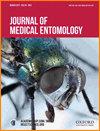The abundance and distribution of sandflies (with emphasis on Phlebotomus pedifer) (Diptera: Psychodidae) along the altitudinal gradient in Kindo Didaye district, Wolaita Zone, South Ethiopia
IF 2
3区 农林科学
Q1 ENTOMOLOGY
引用次数: 0
Abstract
Understanding the distribution patterns of medically significant sandflies is crucial for effective vector and disease control planning. This study focused on investigating the abundance and distribution of phlebotomine sandflies, specifically emphasizing Phlebotomus pedifer (Diptera: Psychodidae), the vector of Leishmania aethiopica responsible for cutaneous leishmaniasis in the highlands of southern Ethiopia. The study employed CDC light traps and sticky paper traps in various habitats, including human houses, farm fields, and rock cliffs, with and without the presence of hyraxes. The study was conducted along an altitudinal gradient in Kindo Didaye district, Wolaita Zone. A total of 7,994 sandflies belonging to 2 genera, Phlebotomus (26.1%) and Sergentomyia (73.9%), were collected. In the genus Phlebotomus, P. pedifer (74.1%) was the most abundant, followed by P. alexandri (18.05%) and P. gibiensis (7.85%). Altitude showed a strong positive association with the density and distribution of P. pedifer and a negative association with those of P. alexandri, P. gibiensis, and Sergentomyia spp. Furthermore, the study revealed distinct habitat preferences, with P. pedifer showing the highest mean density in hyrax dwellings, followed by human houses, and the lowest in farm fields. These findings provide valuable insights for planning targeted control measures against P. pedifer in both indoor and outdoor environments, particularly in the highland and midland areas of the study region.南埃塞俄比亚 Wolaita 区 Kindo Didaye 地区沿海拔梯度的沙蝇(重点是 Phlebotomus pedifer)(双翅目:灵蝇科)的数量和分布情况
了解对医学有重要意义的沙蝇的分布模式对于有效的病媒和疾病控制规划至关重要。这项研究的重点是调查嗜血沙蝇的数量和分布情况,尤其是埃塞俄比亚南部高原地区的嗜血沙蝇(Phlebotomus pedifer,双翅目:Psychodidae),它是皮肤利什曼病的病媒。这项研究采用了 CDC 灯光诱捕器和粘纸诱捕器,在不同的栖息地进行,包括人类房屋、农田和岩石悬崖,有无鬣狗均可。研究在沃莱塔区金多-迪达耶地区沿海拔梯度进行。共收集到 7,994 只沙蝇,分属 Phlebotomus(26.1%)和 Sergentomyia(73.9%)两个属。在沙蝇属中,以 P. pedifer(74.1%)的数量最多,其次是 P. alexandri(18.05%)和 P. gibiensis(7.85%)。海拔高度与 P. pedifer 的密度和分布呈强烈的正相关,而与 P. alexandri、P. gibiensis 和 Sergentomyia spp 的密度和分布呈负相关。 此外,研究还揭示了不同的栖息地偏好,P. pedifer 在鬣羚住所的平均密度最高,其次是人类房屋,而在农田的平均密度最低。这些发现为在室内和室外环境(尤其是在研究区域的高原和中原地区)规划有针对性的小袋鼠控制措施提供了宝贵的见解。
本文章由计算机程序翻译,如有差异,请以英文原文为准。
求助全文
约1分钟内获得全文
求助全文
来源期刊
CiteScore
4.60
自引率
14.30%
发文量
207
审稿时长
3-8 weeks
期刊介绍:
Journal of Medical Entomology is published bimonthly in January, March, May, July, September, and November. The journal publishes reports on all phases of medical entomology and medical acarology, including the systematics and biology of insects, acarines, and other arthropods of public health and veterinary significance. In addition to full-length research articles, the journal publishes Reviews, interpretive articles in a Forum section, Short Communications, and Letters to the Editor.

 求助内容:
求助内容: 应助结果提醒方式:
应助结果提醒方式:


